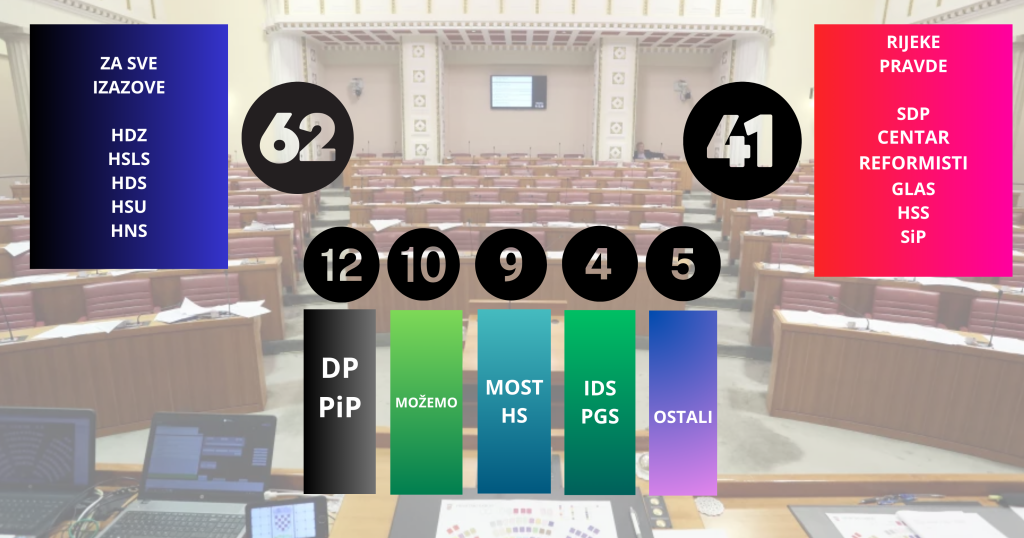April the 3rd, 2024 – Croatian communications expert Krešimir Macan has published a handy calculator that will allow you to calculate how the looming Croatian parliamentary elections might go.
As Kresimir Macan/Manjgura writes, One of the most frequent questions I’ve been asked recently is about how the political parties are faring in terms of seats. With a mere two weeks to go until the parliamentary elections take place, I’ve created a tool that might give us a glimpse into the state of things.
I myself can admit that it’s a tricky question to answer, but it piqued my interest, so I spent the entire afternoon diving into the available data. Here’s the outcome of that analysis: it seems that the ruling HDZ party (Christian Democrats) is still closer to forming a government than the Rijeke pravde (Rivers of Justice) coalition (centre/centre left coalition) is.
This is also why President Zoran Milanović is not stepping down from his current position – he too is aware of the possible scenarios and the president’s crucial role in entrusting the mandate to whoever (fails to) gather 76 signatures.
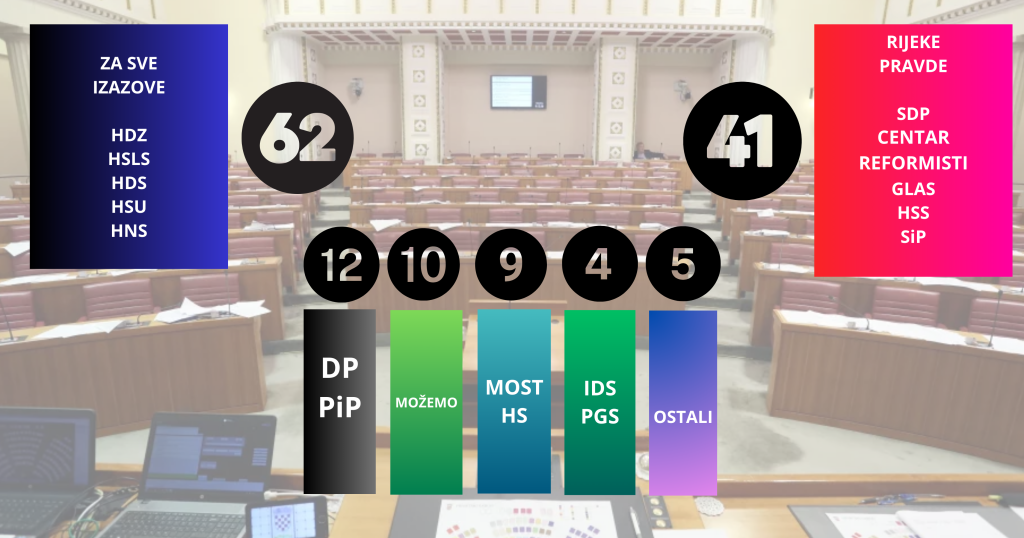
This is just one model to show how difficult it is to make any forecasts in a system with ten electoral units since each one has its own story. However, the release of the lists has clarified some things.
First and foremost, following a nudge from President Zoran Milanović to SDP (Socialdemocrats), the Rijeke pravde coalition (centre/centre left coalition), consisting of SDP, Centar, and other partners, can expect results on a par with the previous elections. This is great because they aren’t joining forces with some of the partners they were with last time, which achieved the same outcome.
However, this is also limiting because there isn’t much room for growth given that their competitors on the left include Možemo!/We Can! (left-leaning green party), Fokus/Republika (liberal coalition), Nezavisna platforma sjever (Regional Party), Radnička fronta (Left Wing), IDS/PGS (Istria regional party/Primorje regional party), and even Richard Nezavisni (Independent), while HDZ faces threats from the right with the Domovinski Pokret/Homeland Movement (Right Wing) and Most/Bridge (Conservatives) parties, as well as Odlučnost i pravednost/Decisiveness and Justice (Right Wing) by Karolina Vidović Krišto, as well as numerous small right-wing options that again are all entering in a fragmented state.
The foundation was based on the results of the 2020 parliamentary elections and the available public opinion research to date, including the latest publicly available public opinion poll, Crobarometar, from April 25, 2024. You can also take a look at the model for the 2020 elections – Elections 2020: Small parties on the left may disrupt the plans of Restart.
I. Electoral Unit – Zagreb Centre and East
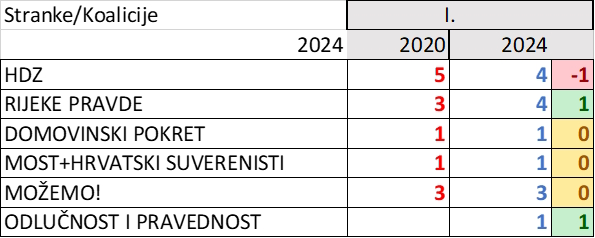
The winners from the 2020 elections, HDZ, are entering into a coalition with the HSLS (liberals), HDS (Christian Democrats), HNS (liberals), and HSU (pensioners intrests) at the national level. In this electoral unit, they can expect to secure four seats, one less than in 2020, as evidenced by their candidate list: 1. Andrej Plenković, 2. Željko Reiner, 3. Nina Obuljen Koržinek, 4. Krešimir Ačkar (the mayor of Velika Gorica), marking a slight decrease from their previous performance.
The Rijeke pravde centre left coalition, consisting of SDP, Centar, HSS, SiP, Reformisti, and Glas, is also anticipating four seats, which is an increase of one seat compared to their last outing. Their running champions are 1. Arsen Bauk, 2. Dalija Orešković, 3. Branko Kolarić, 4. Marijana Puljak. Lana Pavić from the Centar party might attempt to make a significant impact through preferential votes, though it will be quite a challenge.
Možemo! last secured three seats, with no change expected this time, although there’s a hope for a fourth seat given the list’s lineup – 1. Sandra Benčić, 2. Ivana Kekin, 3. Damir Bakić, 4. Teodor Celakoski. With the electoral unit now purely encompassing Zagreb up to Velika Gorica, there’s a chance that the left could outperform the right in terms of seats, despite the large number of candidates and lists likely causing some votes to fall below the 5% threshold.
MOST, in coalition with the Hrvatski suverenisti (right wing), HKS (Conservatives), and NLM (youth party), is expected to maintain their single seat, likely to be won by Marija Selak Raspudić.
Domovinski pokret and their partners Pravo i Pravda (right wing) intend to surpass their single-seat tally (unchanged from last time) with a strategic lineup featuring two prominent names – 1. Mislav Kolakušić, 2. Zlatko Hasanbegović. However, their efforts might be thwarted by Karolina Vidović Krišto (+1) from her party, Odlučnost i pravednost, which has apparently assessed its best chances in the heart of Zagreb.
Damir Vanđelić from the Republika/Fokus coalition and Davorko Vidović from the coalition consisting of Socijaldemokrati (Socialdemocrats), IDS, PGS, Laburisti and Demokrati (centre left) are hopeful to outperform the favorites. In the following, I won’t detail the coalitions as extensively since they largely repeat across all electoral districts except in the 7th and 8th, where the Reformisti (centre left) switch coalitions.
II. Electoral Unit – East Zagreb to Bjelovar
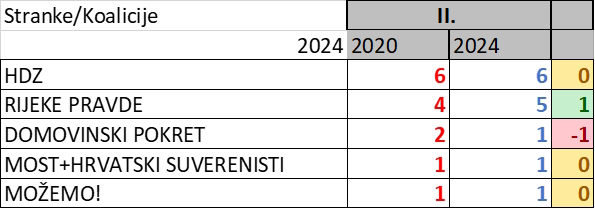
HDZ aims to secure 6 seats (no change) with its heavy hitters leading the list: 1. Gordan Jandroković 2. Krunoslav Katičić 3. Dario Hrebak 4. Ante Deur 5. Gordan Grlić-Radman 6. Miro Totgergeli – with the sixth seat being potentially up for grabs.
The Rijeke pravde coalition is hoping to gain a fifth seat (+1) in a slightly more right-leaning electoral district, which is quite ambitious – 1. Boris Lalovac 2. Tanja Sokolić 3. Anka Mrak-Taritaš 4. Tomislav Golubić 5. Davorka Moslavac Forjan.
Their plan could be thwarted by any member of the trio – Damir Bajs from Fokus/Republika coalition seeking a seat, Domovinski pokret securing 1 seat (-1) – 1. Tomislav Josić, or MOST– with two heavyweights 1. Nino Raspudić 2. Trpimir Goluža, currently holding 1 seat (no change). Additionally, renowned handball player Vlado Šola, representing the Socijaldemokrati, might also disrupt their calculations.
Možemo! is expecting to maintain its single seat (no change) – 1. Danijela Dolenec.
III. Electoral Unit – North Croatia – Krapina, Varaždin, Čakovec
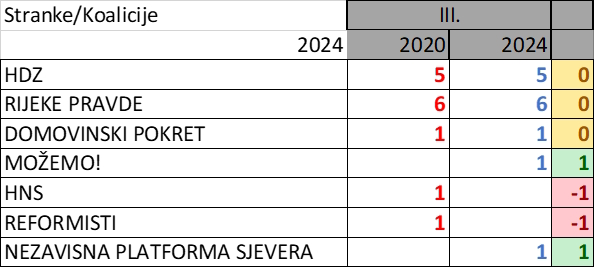
The Rijeke pravde coalition aim for 6 seats (no change) in a somewhat left-leaning electoral district, now that they have the Reformisti in their coalition. The list includes: 1. Siniša Hajdaš Dončić 2. Barbara Antolić Vupora 3. Željko Kolar 4. Boška Ban Vlahek 5. Miroslav Marković 6. Jasenka Auguštan-Pentek. They could, however, be taken by surprise through preferential votes by Natalija Martinčević from Reformisti, positioned seventh on the list.
HDZ appears solid with 5 seats (no change), now in alliance with the HNS. Their candidates are 1. Anđelko Stričak 2. Zoran Gregurović 3. Ljubomir Kolarek 4. Predrag Štromar 5. Damir Habijan – notably at a pivotal fifth spot.
Možemo! anticipates gaining an additional seat (+1) – with 1. Luka Korlaet, similar to the Nezavisna platforma sjevera led by Matija Posavec (+1), while the Domovinski pokret maintains its single seat (no change) – 1. Davor Dretar.
Contending for a seat is a champion for the victims of Swiss Franc loans and one of the more notable representatives up to 2020, Goran Aleksić for Fokus/Republika, from the 14th place on an independent list. The presidential challenger of 2019, Dario Juričan, is also in the race, while MOST hopes for a seat with their duo 1. Željko Sačić 2. Robert Podolnjak, despite not having one in 2020.
IV. Electoral Unit – Eastern Slavonia from Koprivnica to Osijek
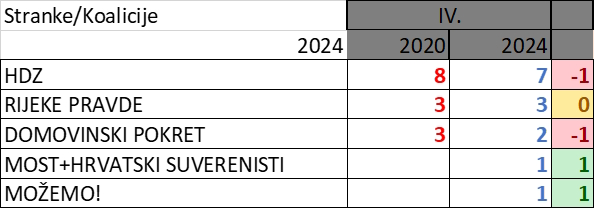
HDZ, in one of their strongholds, anticipates winning 7 seats (-1) with the following candidates: 1. Ivan Anušić, 2. Igor Andrović, 3. Darko Sobota, 4. Ivan Radić, 5. Nataša Tramišak, 6. Goran Ivanović, and 7. Josip Đakić.
The Rijeke pravde coalition is aiming for 3 seats (no change) – 1. Mišel Jakšić, Mayor of Koprivnica, 2. Sanja Bježančević, and 3. Boris Piližota, with Biljana Borzan posing a threat from the 14th position through preferential votes.
Domovinski pokret might maintain 2 seats (-1) – 1. Mario Radić and 2. Jesenka Ricl, although they are hoping to secure a third seat through preferential votes for Željko Lacković, an independent from the Koprivnica-Križevci County, now part of this electoral district.
MOST– 1. Josip Skočibušić and Možemo! with 1. Katarina Kruhonja could each gain their first seats (each +1).
The Socijaldemokrati will attempt to win 1 seat with 1. Domagoj Hajduković.
V. Electoral Unit – From Vukovar to Nova Gradiška and Slavonski Brod

HDZ is poised for a slight decrease, expecting one seat less for a total of 7 (-1) – 1. Marin Piletić 2. Ivan Bosančić 3. Pero Ćosić 4. Antonija Jozić 5. Nikola Mažar 6. Danijel Marušić 7. Željko Glavić – with the following currently below the threshold: 8. Josip Šarić 9. Tomislav Zadro.
This electoral district is also a stronghold for the Domovinski pokret, which is projected to retain its 3 seats without any changes – 1. Ivan Penava 2. Josip Dabro 3. Dubravka Lipovac Pehar. However, they’re potentially losing one seat (+1) to 1. Marijan Pavliček from Hrvatski suverenisti, who are in a coalition with MOST.
Rijeke pravde coalition is expected to maintain their standard 3 seats, showing no change – 1. Predrag Fred Matić 2. Martina Vlašić Iljkić 3. Mario Milinković. Also seeking an opportunity is 1. Dario Marenić, an entrepreneur from Nova Gradiška, representing Fokus/Republika.
VI. Electoral Unit – West Zagreb, Samobor, Zaprešić and Jastrebarsko
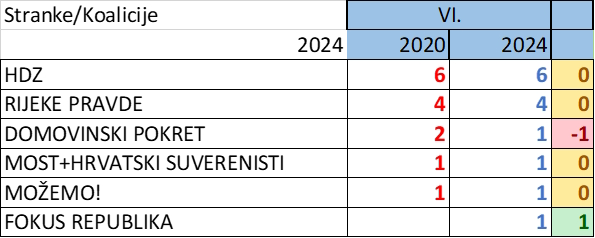
Although this electoral district has undergone quite a few changes since 2020, the leading candidates largely remain the same. HDZ anticipates securing the same six seats (no change) – with Davor Božinović at the forefront, followed by Vili Beroš, Mislav Herman, Marko Primorac, Željko Turk, and Davor Ivo Stier. Similarly, the Rijeke pravde coalition expects at least four seats (no change) – led by Mihael Zmajlović, Marija Lugarić, Krešo Beljak, and Ivan Račan, with Alka Vuica possibly securing the 14th spot.
This potential fifth seat for Rijeke pravde is likely being edged out by Fokus/Republika, not through its top candidate Davor Nađi, but rather through the preferential votes for Dario Zurovec, the mayor of Sveta Nedelja, positioned at 14th.
Možemo! is counting on one seat (no change) – with Tomislav Tomašević at the helm, who will delegate his parliamentary duties to Urša Raukar-Gamulin due to the incompatibility of holding multiple offices.
Domovinski pokret is expected to secure at least one seat (a decrease of one) – with Igor Peternel leading, as well as the Most party’s Nikola Grmoja.
VII. Electoral Unit – From Sisak to Lika and Gorski kotar to Matulji and Novalja

Despite being significantly affected by the changes, HDZ can anticipate a similar outcome of securing 6 seats (no change), although they aspire for at least 8, given the strong and well-known names on their list. This includes the president of HSU, Gabričević, and one of the wartime commanders of the defense of Dubrovnik—1. Tomo Medved 2. Ivan Celjak, the prefect of Sisak-Moslavina County 3. Martina Furdek-Hajdin 4. Marijana Petir 5. Ernest Petry, the prefect of Lika-Senj County 6. Veselko Gabričević, with the currently non-qualifying 7. Nikolina Brnjac 8. Majda Burić, who will still enter the Parliament as deputies for the two prefects.
SDP also has strong candidates for this electoral unit, expecting to win 5 seats (an increase of 1)—1. Kristina Ikić Baniček, the mayor of Sisak 2. Ivica Lukanović, an entrepreneur and former mayor of Kastav, likely to succeed Zlatko Komadina as the prefect of Primorje-Gorski Kotar County 3. Sandra Krpan, deputy mayor of Rijeka 4. Dalibor Domitrović 5. Branka Bakšić-Mitić from Glina, and symbolically at the 14th position, Vojko Obersnel, the former long-term mayor of Rijeka.
Možemo! expects to secure 1 seat, as do Domovinski pokret with 1. Josip Jurčević and MOST with 1. Zvonimir Troskot, all expecting 1 seat each (no change).
They will face competition from the Hrvatska Stranka Prava (right wing) with 1. Ante Prkačin, and the Reformisti, who, unlike in the eighth electoral district, are not aligning with the SDP but with the IDS and PGS—1. Alenka Košiša Čičin-Šain, as well as the Socijaldemokrati with 1. Nataša Novaković. This presents the curiosity that two former presidents of the Commission for the Resolution of Conflicts of Interest are candidates in the new elections, with Dalija Orešković almost certainly returning to Parliament.
VIII. Electoral Unit – Rijeka, Istria and islands
I must disclose that I’m part of the IDS-PGS coalition for this election, giving me a deep understanding of the dynamics in this electoral district, which could potentially see the most surprises. The situation here is fluid and could easily shift.
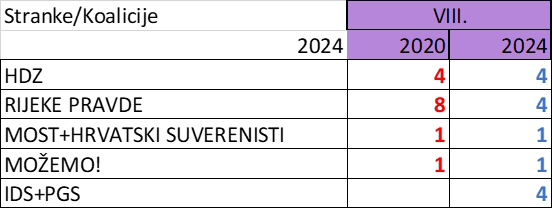
Rijeke pravde coalition, in their stronghold, face numerous challengers, but currently, they can confidently expect 4 seats (previously, they formed a coalition with IDS and PGS, so we might say that’s a decrease of one seat). It’s clear from the composition of their list that they are targeting a fifth seat – 1. Peđa Grbin 2. Mirela Ahmetović 3. Zlatko Komadina 4. Sanja Radolović 5. Saša Đujić. However, they might fall short of votes for that fifth seat, possibly needing support from the Radnička fronta (left wing), with 1. Katarina Peović, or from those in Fokus/Republika, who are running for the first time with the renowned entrepreneur from Pula, 1. Gordana Deranja.
HDZ aims to secure more than the 4 seats they are currently confident of, which would be a significant achievement if they manage to replicate their performance from the last election (no change) – 1. Oleg Butković 2. Anton Kliman 3. Josip Ostrogović 4. Tomislav Klarić.
IDS is part of a broad centre and centre left coalition – Primorsko Goranski Savez, Unija Kvarnera, Istarska Stranka Umirovljenika, Socijaldemokrati, Reformisti, Demokrati, and Hrvatski Laburisti – 1. Dalibor Paus 2. Darijo Vasilić 3. Valter Glavičić 4. Loris Peršurić, aiming to secure a fourth seat for the first time, which seems within reach (+1). However, the campaign’s final details and the election day dynamics will be crucial.
MOST is expected to retain 1 seat (no change) with 1. Marin Miletić. It remains to be seen who will secure 1 seat for Možemo – either 1. Dušica Radojčić or 14. Suzana Jašić, the mayor of Pazin, potentially increasing their seats to two.
Domovinski Pokret hopes for a surprise with 1. Ivan Vilibor Sinčić leading the charge.
IX. Electoral Unit – Zadar, Šibenik, Trogir, Sinj to Kaštela and Solin
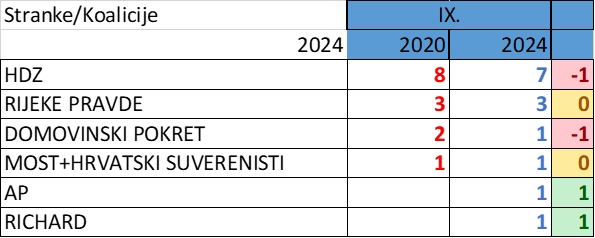
In this stronghold, HDZ can anticipate securing 7 seats (a decrease of one) due to the significant competition on the right – 1. Ivan Malenica 2. Šime Erlić 3. Ante Sanader 4. Branka Juričev-Martinčev 5. Josip Bilaver 6. Ivan Bugarin 7. Hrvoje Zekanović, with additional support for 14. Željko Burić, the mayor of Šibenik.
Rijeke pravde coalition is expected to maintain their 3 seats (no change) – 1. Sabina Glasovac 2. Tonči Restović 3. Irena Dragić, facing competition from their former colleagues in the Socijaldemokrati – 1. Franko Vidović, and from Možemo! – 1. Maja Šintić.
Domovinski Pokret is down to 1 seat (a loss of one) – 1. Damir Biloglav, similar to MOST (no change) – 1. Miro Bulj. A single seat could also be won by the former mayor of Knin and the current Šibenik-Knin County prefect, 1. Marko Jelić from Akcija za promjene (whose 16,557 votes in the first round of the 2021 county elections are more than enough for at least one seat), and 1. Marin Pijaca from the newly formed party Richard Nezavisni Enio Meštrović (his 5,346 votes in the 2021 Zadar local elections might not be enough for a seat on their own, but knowing Enio, an entertaining show is expected), who also personally ran in the 10th electoral district.
It will be intriguing to follow the outcome for the Hrvatska stranka prava, which evidently believes it can win a seat here, just look at their list – 1. Željko Glasnović 2. Angelo Žilić 3. Marko Skejo 4. Luka Podrug.
X. Electoral Unit – From Split to Dubrovnik
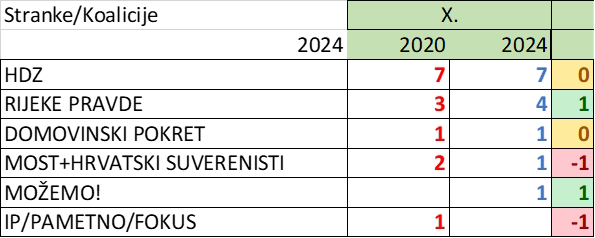
If HDZ once again secures 7 seats as in the previous elections (no change), the question arises about who will be left without a seat on the right. The list is strong – 1. Branko Bačić 2. Blaženko Boban 3. Tomislav Šuta 4. Mato Franković 5. Andro Krstulović Opara 6. Marija Vučković 7. Danica Baričević, with Damir Krstičević in the 14th spot to draw in preferential votes.
If that remains, MOST will have one seat (a loss of one) – 1. Božo Petrov, as will Domovinski Pokret (no change) – 1. Stipo Mlinarić.
Thanks to the Centar party, the Rijeke pravde coalition can count on at least 4 seats (+1) – 1. Ranko Ostojić 2. Ivica Puljak 3. Ivana Marković 4. Mišo Krstičević – all prominent names of mayors.
Možemo! and the political platform Srđ je Grad will aim for an additional seat (+1) – 1. Đuro Capor – otherwise, that seat likely goes to the Rijeke pravde coalition. Of course, unless Richard Nezavisni – 1. Enio Meštrović mixes things up.
XI. Electoral Unit – Bosnia and Herzegovina and rest of the World
It’s expected that HDZ will retain all 3 seats from 2020 (no change) – 1. Zvonko Milas 2. Nevenko Barbarić 3. Radoje Vidović, although President Zoran Milanović will also attempt to secure a seat for Rijeke pravde (despite SDP, by his decision, never running a list in the 11th Electoral District since 2007). Generals from Hrvatsko bilo – 1. Ljubo Ćesić 2. Ivan Tolj, will also vie for that seat.
And there we have it at the end – this also answers why President Zoran Milanović didn’t wish to resign from the presidency to campaign – he is the one who will grant the mandate to anyone who brings him 76 signatures as he did in 2020. With HDZ’s 62 seats and 8 minority seats, they need just 6 more hands to succeed. Forming a coalition around the Rijeke pravde coalition will be much more challenging – you can do the maths.
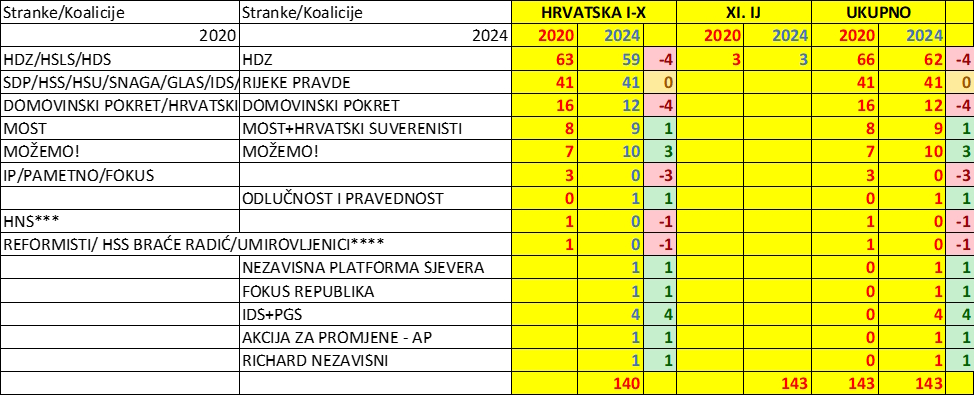
This represents just one of the numerous potential scenarios for these elections – it’s a practice exercise to help you understand what to watch for, where changes might occur, and what kind of changes they might be. Parties have conducted research in various electoral districts prior to the surprise announcement by President Zoran Milanović. You can glean some insights from the names on the lists and their placement in secure and competitive spots, which is why I’ve included ordinal numbers for you to see who is positioned where. Then, by looking at past results, you can make some estimations about what might happen and what might change. However, this is just one of many possible predictions.
Of course, surprises are always possible and expected; you just never know where they’re going to come from, or else they wouldn’t be surprises. The campaign is there to change some things – we’ll see how successful various parties will be in this endeavor. Unfortunately, this part of the campaign and its culmination are often underestimated by most players, even though research shows that every fourth voter makes their decision in the last two weeks of the campaign.
All suggestions and corrections are more than welcome and I will keep updating here – so here is my first reaction to comments – a new blog Results of parliamentary elections 2015-2020 – what is important to note?. I will keep sharing any updates here.
All data and illustrations can be freely shared with credit to the author and source.

